Organisation and Behaviour Report
VerifiedAdded on 2020/01/15
|12
|4052
|406
Report
AI Summary
This report analyzes the organizational behavior of CAPCO, a multinational financial services company, comparing and contrasting its structure and culture with that of BB&T. It examines the impact of the relationship between CAPCO's structure and culture on operational performance, identifies factors influencing individual behavior, and compares the effectiveness of different leadership styles at both companies. The report also explores the influence of organizational theories on management practices, evaluates different management approaches used by CAPCO, discusses the impact of leadership styles on motivation, compares the application of Maslow's need hierarchy and Herzberg's two-factor theories, and explains the necessity for managers to understand and apply motivation theories. Finally, it examines the nature of groups and group behavior within CAPCO, discusses factors that promote or inhibit effective teamwork, and evaluates the impact of technology on team functioning. The report concludes by summarizing the key findings and emphasizing the importance of understanding human behavior for organizational success.
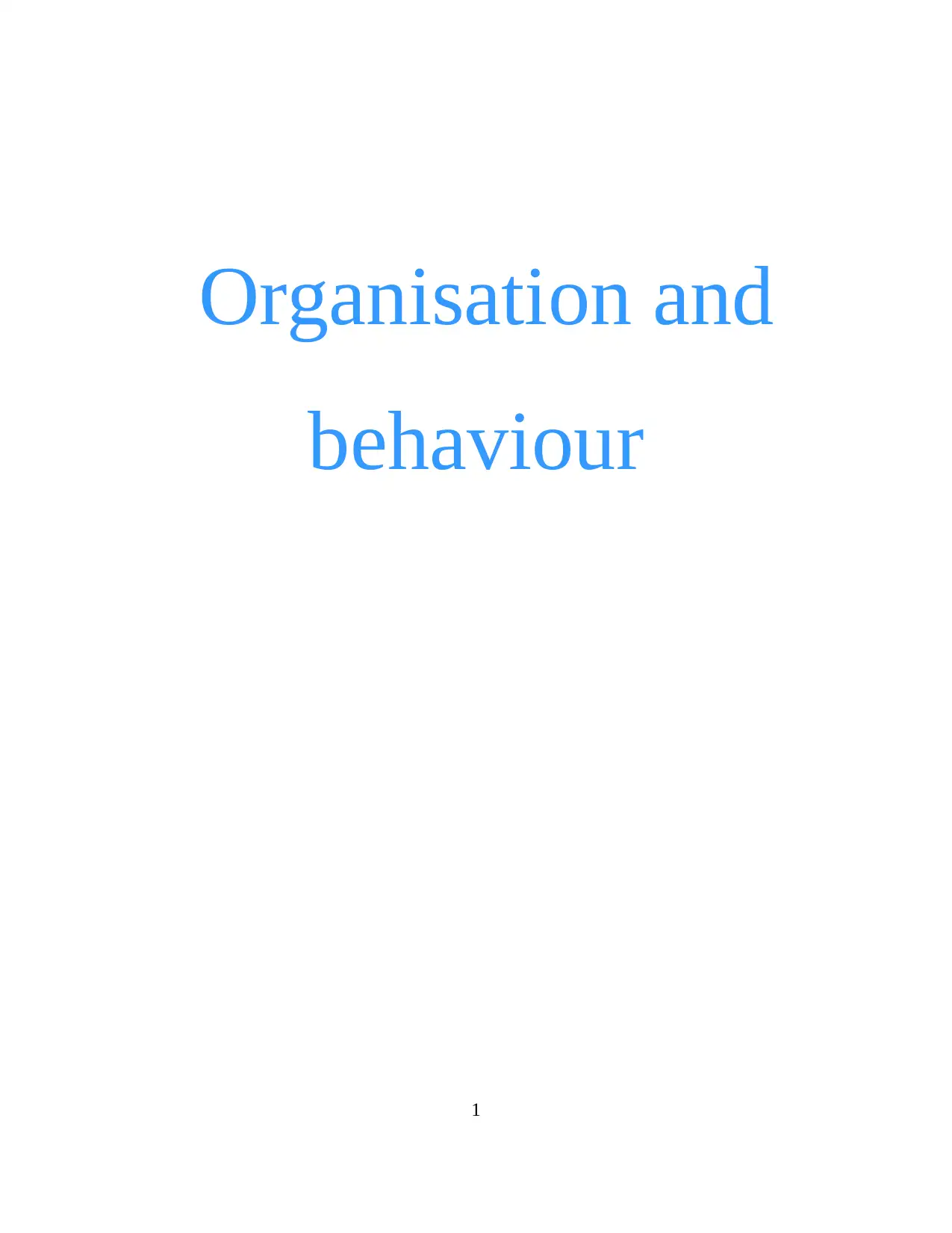
Organisation and
behaviour
1
behaviour
1
Paraphrase This Document
Need a fresh take? Get an instant paraphrase of this document with our AI Paraphraser
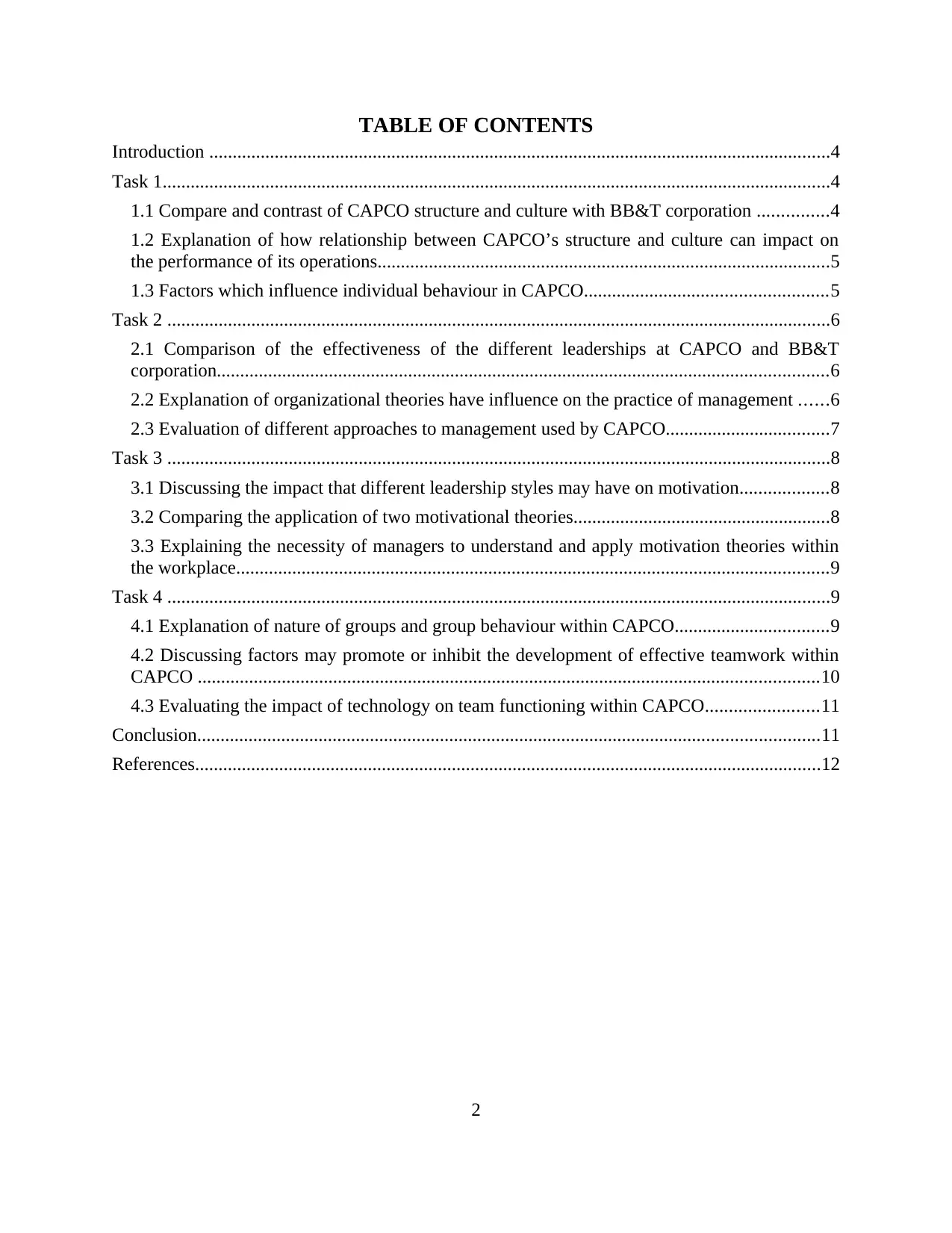
TABLE OF CONTENTS
Introduction .....................................................................................................................................4
Task 1...............................................................................................................................................4
1.1 Compare and contrast of CAPCO structure and culture with BB&T corporation ...............4
1.2 Explanation of how relationship between CAPCO’s structure and culture can impact on
the performance of its operations.................................................................................................5
1.3 Factors which influence individual behaviour in CAPCO....................................................5
Task 2 ..............................................................................................................................................6
2.1 Comparison of the effectiveness of the different leaderships at CAPCO and BB&T
corporation...................................................................................................................................6
2.2 Explanation of organizational theories have influence on the practice of management ......6
2.3 Evaluation of different approaches to management used by CAPCO...................................7
Task 3 ..............................................................................................................................................8
3.1 Discussing the impact that different leadership styles may have on motivation...................8
3.2 Comparing the application of two motivational theories.......................................................8
3.3 Explaining the necessity of managers to understand and apply motivation theories within
the workplace...............................................................................................................................9
Task 4 ..............................................................................................................................................9
4.1 Explanation of nature of groups and group behaviour within CAPCO.................................9
4.2 Discussing factors may promote or inhibit the development of effective teamwork within
CAPCO .....................................................................................................................................10
4.3 Evaluating the impact of technology on team functioning within CAPCO........................11
Conclusion.....................................................................................................................................11
References......................................................................................................................................12
2
Introduction .....................................................................................................................................4
Task 1...............................................................................................................................................4
1.1 Compare and contrast of CAPCO structure and culture with BB&T corporation ...............4
1.2 Explanation of how relationship between CAPCO’s structure and culture can impact on
the performance of its operations.................................................................................................5
1.3 Factors which influence individual behaviour in CAPCO....................................................5
Task 2 ..............................................................................................................................................6
2.1 Comparison of the effectiveness of the different leaderships at CAPCO and BB&T
corporation...................................................................................................................................6
2.2 Explanation of organizational theories have influence on the practice of management ......6
2.3 Evaluation of different approaches to management used by CAPCO...................................7
Task 3 ..............................................................................................................................................8
3.1 Discussing the impact that different leadership styles may have on motivation...................8
3.2 Comparing the application of two motivational theories.......................................................8
3.3 Explaining the necessity of managers to understand and apply motivation theories within
the workplace...............................................................................................................................9
Task 4 ..............................................................................................................................................9
4.1 Explanation of nature of groups and group behaviour within CAPCO.................................9
4.2 Discussing factors may promote or inhibit the development of effective teamwork within
CAPCO .....................................................................................................................................10
4.3 Evaluating the impact of technology on team functioning within CAPCO........................11
Conclusion.....................................................................................................................................11
References......................................................................................................................................12
2
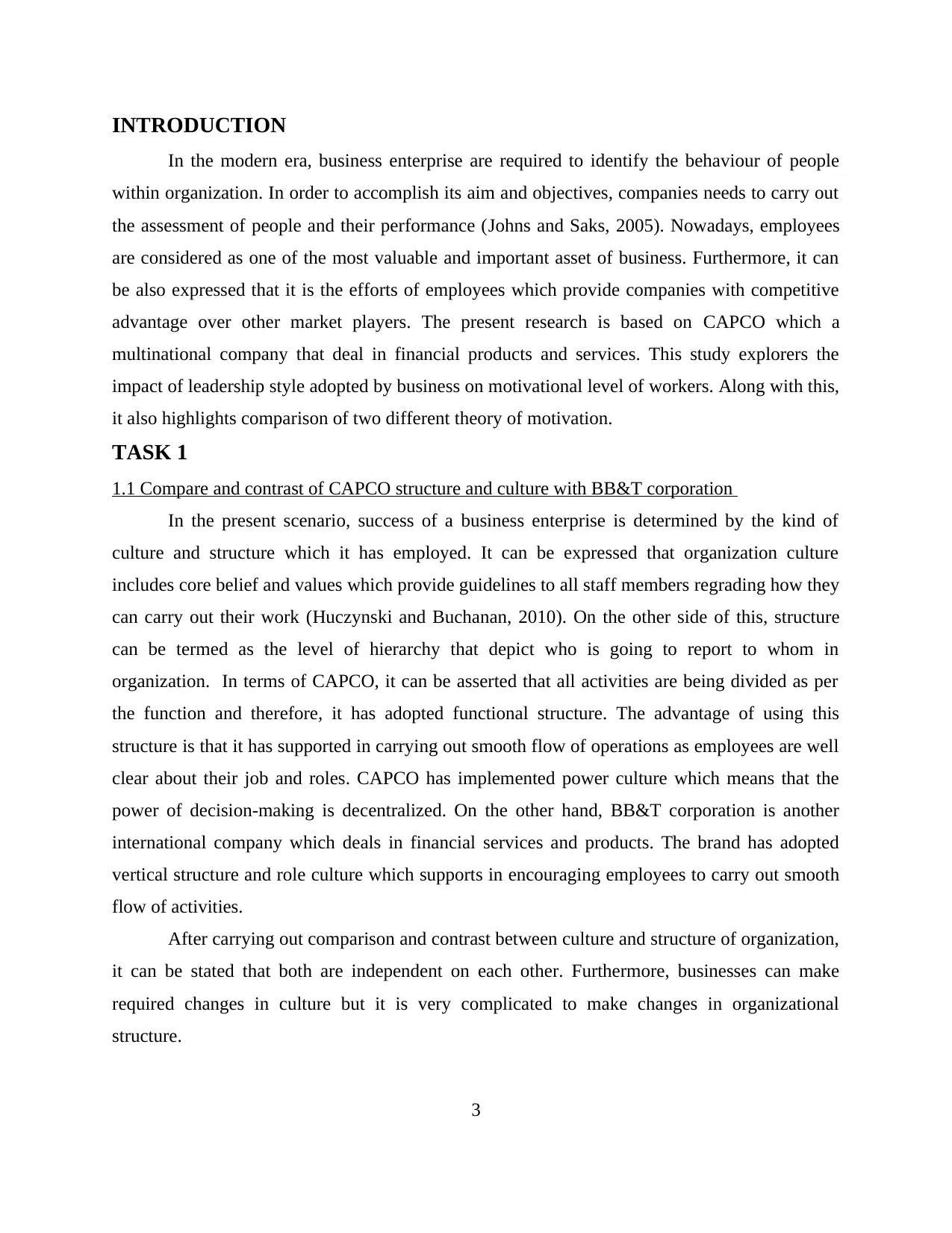
INTRODUCTION
In the modern era, business enterprise are required to identify the behaviour of people
within organization. In order to accomplish its aim and objectives, companies needs to carry out
the assessment of people and their performance (Johns and Saks, 2005). Nowadays, employees
are considered as one of the most valuable and important asset of business. Furthermore, it can
be also expressed that it is the efforts of employees which provide companies with competitive
advantage over other market players. The present research is based on CAPCO which a
multinational company that deal in financial products and services. This study explorers the
impact of leadership style adopted by business on motivational level of workers. Along with this,
it also highlights comparison of two different theory of motivation.
TASK 1
1.1 Compare and contrast of CAPCO structure and culture with BB&T corporation
In the present scenario, success of a business enterprise is determined by the kind of
culture and structure which it has employed. It can be expressed that organization culture
includes core belief and values which provide guidelines to all staff members regrading how they
can carry out their work (Huczynski and Buchanan, 2010). On the other side of this, structure
can be termed as the level of hierarchy that depict who is going to report to whom in
organization. In terms of CAPCO, it can be asserted that all activities are being divided as per
the function and therefore, it has adopted functional structure. The advantage of using this
structure is that it has supported in carrying out smooth flow of operations as employees are well
clear about their job and roles. CAPCO has implemented power culture which means that the
power of decision-making is decentralized. On the other hand, BB&T corporation is another
international company which deals in financial services and products. The brand has adopted
vertical structure and role culture which supports in encouraging employees to carry out smooth
flow of activities.
After carrying out comparison and contrast between culture and structure of organization,
it can be stated that both are independent on each other. Furthermore, businesses can make
required changes in culture but it is very complicated to make changes in organizational
structure.
3
In the modern era, business enterprise are required to identify the behaviour of people
within organization. In order to accomplish its aim and objectives, companies needs to carry out
the assessment of people and their performance (Johns and Saks, 2005). Nowadays, employees
are considered as one of the most valuable and important asset of business. Furthermore, it can
be also expressed that it is the efforts of employees which provide companies with competitive
advantage over other market players. The present research is based on CAPCO which a
multinational company that deal in financial products and services. This study explorers the
impact of leadership style adopted by business on motivational level of workers. Along with this,
it also highlights comparison of two different theory of motivation.
TASK 1
1.1 Compare and contrast of CAPCO structure and culture with BB&T corporation
In the present scenario, success of a business enterprise is determined by the kind of
culture and structure which it has employed. It can be expressed that organization culture
includes core belief and values which provide guidelines to all staff members regrading how they
can carry out their work (Huczynski and Buchanan, 2010). On the other side of this, structure
can be termed as the level of hierarchy that depict who is going to report to whom in
organization. In terms of CAPCO, it can be asserted that all activities are being divided as per
the function and therefore, it has adopted functional structure. The advantage of using this
structure is that it has supported in carrying out smooth flow of operations as employees are well
clear about their job and roles. CAPCO has implemented power culture which means that the
power of decision-making is decentralized. On the other hand, BB&T corporation is another
international company which deals in financial services and products. The brand has adopted
vertical structure and role culture which supports in encouraging employees to carry out smooth
flow of activities.
After carrying out comparison and contrast between culture and structure of organization,
it can be stated that both are independent on each other. Furthermore, businesses can make
required changes in culture but it is very complicated to make changes in organizational
structure.
3
⊘ This is a preview!⊘
Do you want full access?
Subscribe today to unlock all pages.

Trusted by 1+ million students worldwide
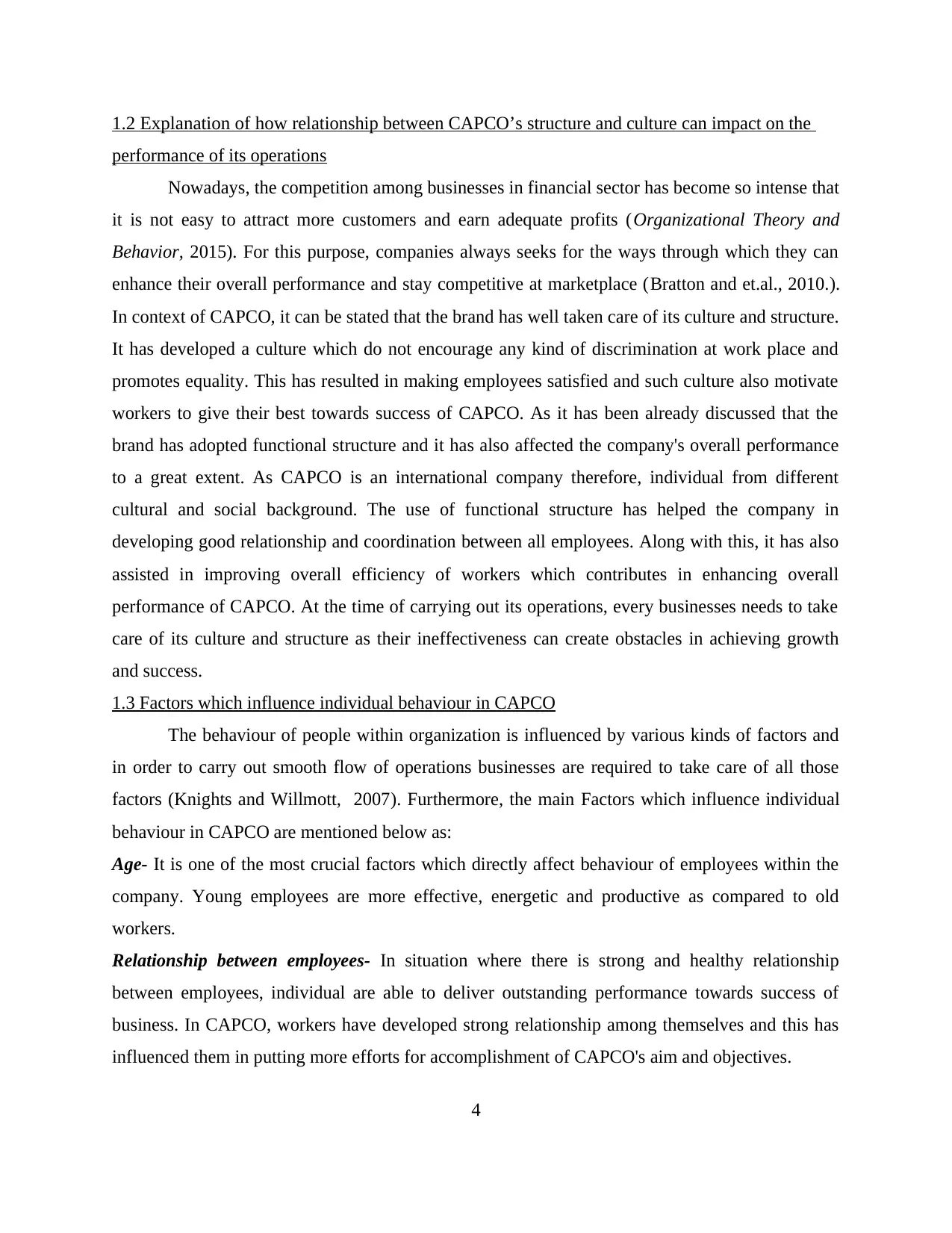
1.2 Explanation of how relationship between CAPCO’s structure and culture can impact on the
performance of its operations
Nowadays, the competition among businesses in financial sector has become so intense that
it is not easy to attract more customers and earn adequate profits (Organizational Theory and
Behavior, 2015). For this purpose, companies always seeks for the ways through which they can
enhance their overall performance and stay competitive at marketplace (Bratton and et.al., 2010.).
In context of CAPCO, it can be stated that the brand has well taken care of its culture and structure.
It has developed a culture which do not encourage any kind of discrimination at work place and
promotes equality. This has resulted in making employees satisfied and such culture also motivate
workers to give their best towards success of CAPCO. As it has been already discussed that the
brand has adopted functional structure and it has also affected the company's overall performance
to a great extent. As CAPCO is an international company therefore, individual from different
cultural and social background. The use of functional structure has helped the company in
developing good relationship and coordination between all employees. Along with this, it has also
assisted in improving overall efficiency of workers which contributes in enhancing overall
performance of CAPCO. At the time of carrying out its operations, every businesses needs to take
care of its culture and structure as their ineffectiveness can create obstacles in achieving growth
and success.
1.3 Factors which influence individual behaviour in CAPCO
The behaviour of people within organization is influenced by various kinds of factors and
in order to carry out smooth flow of operations businesses are required to take care of all those
factors (Knights and Willmott, 2007). Furthermore, the main Factors which influence individual
behaviour in CAPCO are mentioned below as:
Age- It is one of the most crucial factors which directly affect behaviour of employees within the
company. Young employees are more effective, energetic and productive as compared to old
workers.
Relationship between employees- In situation where there is strong and healthy relationship
between employees, individual are able to deliver outstanding performance towards success of
business. In CAPCO, workers have developed strong relationship among themselves and this has
influenced them in putting more efforts for accomplishment of CAPCO's aim and objectives.
4
performance of its operations
Nowadays, the competition among businesses in financial sector has become so intense that
it is not easy to attract more customers and earn adequate profits (Organizational Theory and
Behavior, 2015). For this purpose, companies always seeks for the ways through which they can
enhance their overall performance and stay competitive at marketplace (Bratton and et.al., 2010.).
In context of CAPCO, it can be stated that the brand has well taken care of its culture and structure.
It has developed a culture which do not encourage any kind of discrimination at work place and
promotes equality. This has resulted in making employees satisfied and such culture also motivate
workers to give their best towards success of CAPCO. As it has been already discussed that the
brand has adopted functional structure and it has also affected the company's overall performance
to a great extent. As CAPCO is an international company therefore, individual from different
cultural and social background. The use of functional structure has helped the company in
developing good relationship and coordination between all employees. Along with this, it has also
assisted in improving overall efficiency of workers which contributes in enhancing overall
performance of CAPCO. At the time of carrying out its operations, every businesses needs to take
care of its culture and structure as their ineffectiveness can create obstacles in achieving growth
and success.
1.3 Factors which influence individual behaviour in CAPCO
The behaviour of people within organization is influenced by various kinds of factors and
in order to carry out smooth flow of operations businesses are required to take care of all those
factors (Knights and Willmott, 2007). Furthermore, the main Factors which influence individual
behaviour in CAPCO are mentioned below as:
Age- It is one of the most crucial factors which directly affect behaviour of employees within the
company. Young employees are more effective, energetic and productive as compared to old
workers.
Relationship between employees- In situation where there is strong and healthy relationship
between employees, individual are able to deliver outstanding performance towards success of
business. In CAPCO, workers have developed strong relationship among themselves and this has
influenced them in putting more efforts for accomplishment of CAPCO's aim and objectives.
4
Paraphrase This Document
Need a fresh take? Get an instant paraphrase of this document with our AI Paraphraser
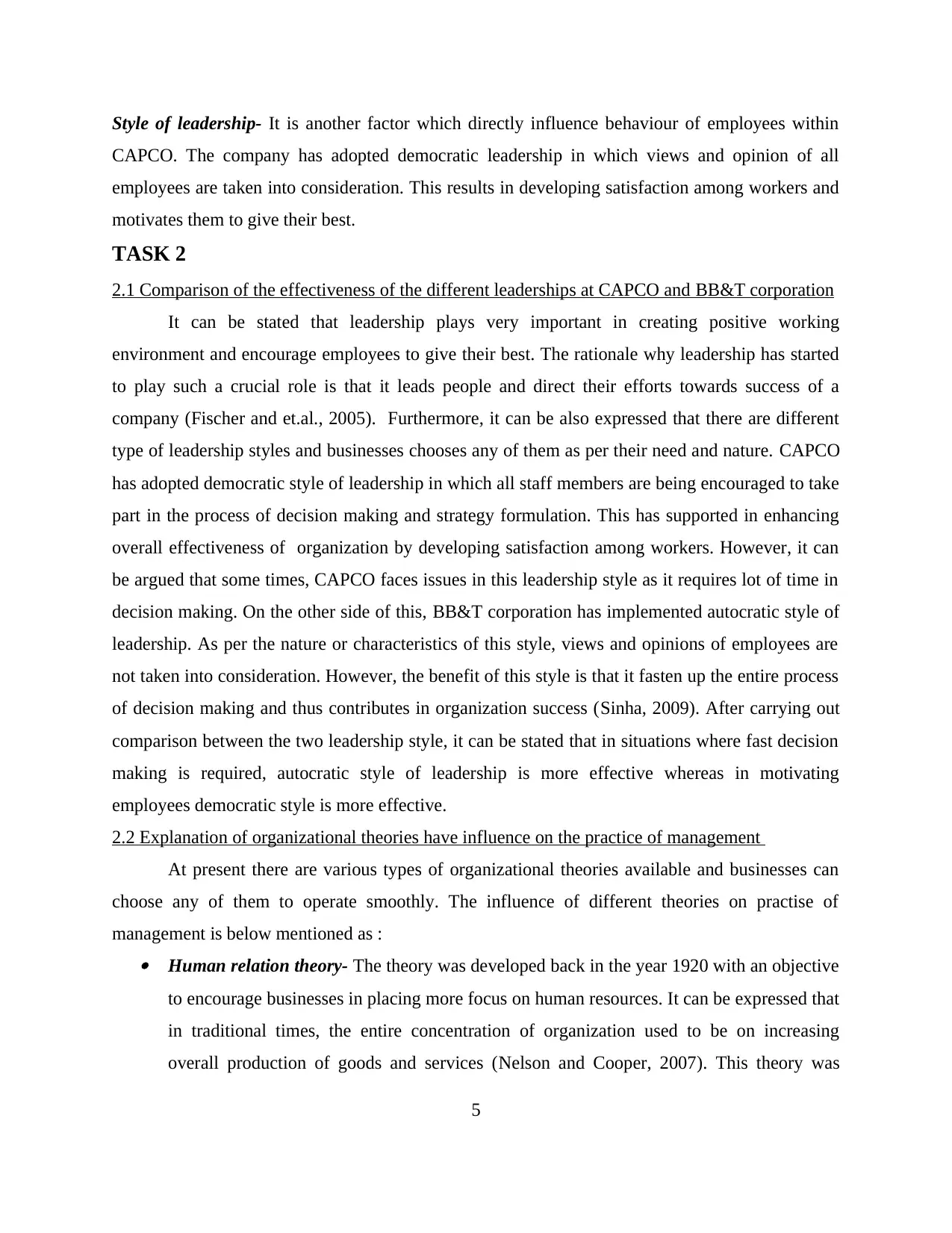
Style of leadership- It is another factor which directly influence behaviour of employees within
CAPCO. The company has adopted democratic leadership in which views and opinion of all
employees are taken into consideration. This results in developing satisfaction among workers and
motivates them to give their best.
TASK 2
2.1 Comparison of the effectiveness of the different leaderships at CAPCO and BB&T corporation
It can be stated that leadership plays very important in creating positive working
environment and encourage employees to give their best. The rationale why leadership has started
to play such a crucial role is that it leads people and direct their efforts towards success of a
company (Fischer and et.al., 2005). Furthermore, it can be also expressed that there are different
type of leadership styles and businesses chooses any of them as per their need and nature. CAPCO
has adopted democratic style of leadership in which all staff members are being encouraged to take
part in the process of decision making and strategy formulation. This has supported in enhancing
overall effectiveness of organization by developing satisfaction among workers. However, it can
be argued that some times, CAPCO faces issues in this leadership style as it requires lot of time in
decision making. On the other side of this, BB&T corporation has implemented autocratic style of
leadership. As per the nature or characteristics of this style, views and opinions of employees are
not taken into consideration. However, the benefit of this style is that it fasten up the entire process
of decision making and thus contributes in organization success (Sinha, 2009). After carrying out
comparison between the two leadership style, it can be stated that in situations where fast decision
making is required, autocratic style of leadership is more effective whereas in motivating
employees democratic style is more effective.
2.2 Explanation of organizational theories have influence on the practice of management
At present there are various types of organizational theories available and businesses can
choose any of them to operate smoothly. The influence of different theories on practise of
management is below mentioned as : Human relation theory- The theory was developed back in the year 1920 with an objective
to encourage businesses in placing more focus on human resources. It can be expressed that
in traditional times, the entire concentration of organization used to be on increasing
overall production of goods and services (Nelson and Cooper, 2007). This theory was
5
CAPCO. The company has adopted democratic leadership in which views and opinion of all
employees are taken into consideration. This results in developing satisfaction among workers and
motivates them to give their best.
TASK 2
2.1 Comparison of the effectiveness of the different leaderships at CAPCO and BB&T corporation
It can be stated that leadership plays very important in creating positive working
environment and encourage employees to give their best. The rationale why leadership has started
to play such a crucial role is that it leads people and direct their efforts towards success of a
company (Fischer and et.al., 2005). Furthermore, it can be also expressed that there are different
type of leadership styles and businesses chooses any of them as per their need and nature. CAPCO
has adopted democratic style of leadership in which all staff members are being encouraged to take
part in the process of decision making and strategy formulation. This has supported in enhancing
overall effectiveness of organization by developing satisfaction among workers. However, it can
be argued that some times, CAPCO faces issues in this leadership style as it requires lot of time in
decision making. On the other side of this, BB&T corporation has implemented autocratic style of
leadership. As per the nature or characteristics of this style, views and opinions of employees are
not taken into consideration. However, the benefit of this style is that it fasten up the entire process
of decision making and thus contributes in organization success (Sinha, 2009). After carrying out
comparison between the two leadership style, it can be stated that in situations where fast decision
making is required, autocratic style of leadership is more effective whereas in motivating
employees democratic style is more effective.
2.2 Explanation of organizational theories have influence on the practice of management
At present there are various types of organizational theories available and businesses can
choose any of them to operate smoothly. The influence of different theories on practise of
management is below mentioned as : Human relation theory- The theory was developed back in the year 1920 with an objective
to encourage businesses in placing more focus on human resources. It can be expressed that
in traditional times, the entire concentration of organization used to be on increasing
overall production of goods and services (Nelson and Cooper, 2007). This theory was
5
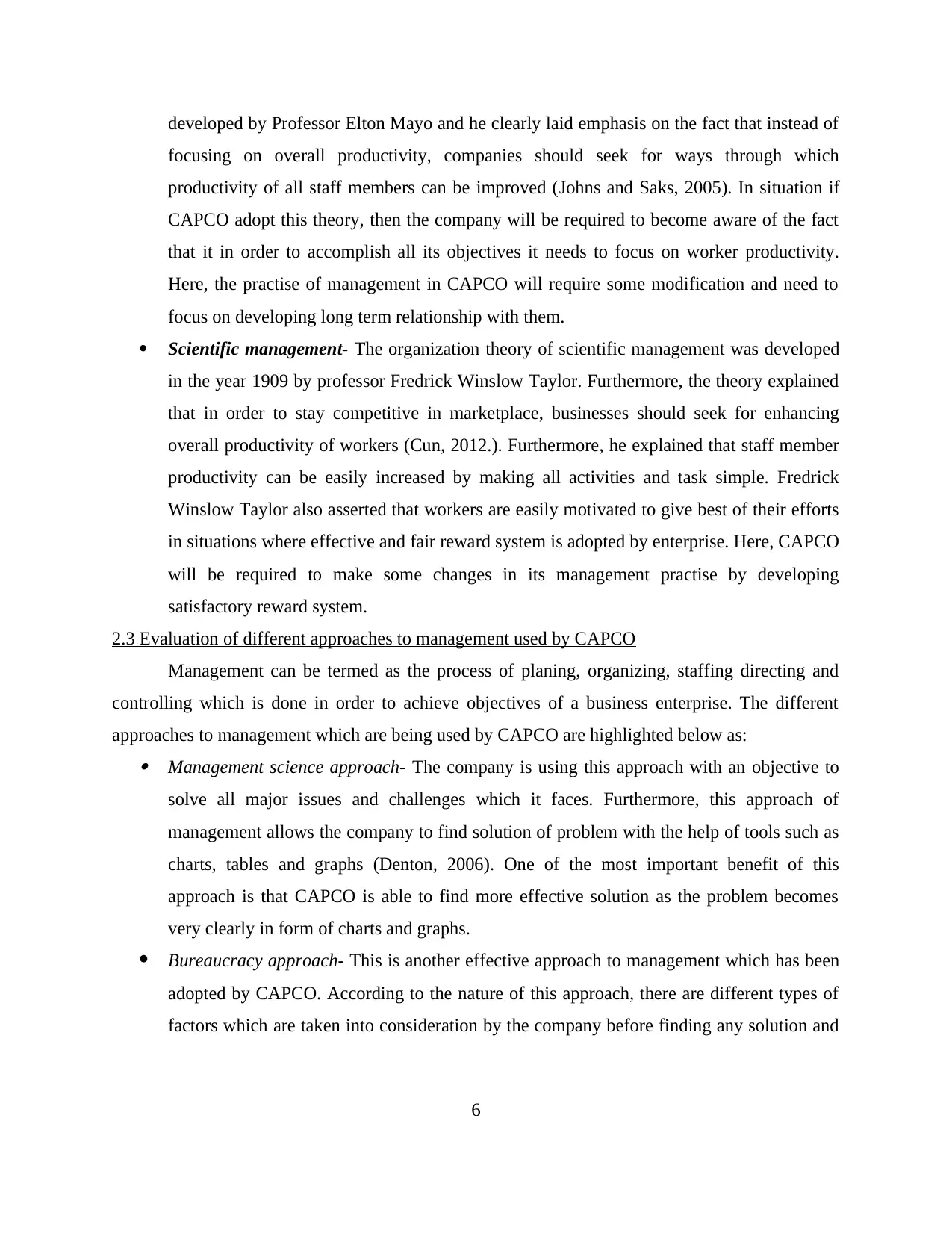
developed by Professor Elton Mayo and he clearly laid emphasis on the fact that instead of
focusing on overall productivity, companies should seek for ways through which
productivity of all staff members can be improved (Johns and Saks, 2005). In situation if
CAPCO adopt this theory, then the company will be required to become aware of the fact
that it in order to accomplish all its objectives it needs to focus on worker productivity.
Here, the practise of management in CAPCO will require some modification and need to
focus on developing long term relationship with them.
Scientific management- The organization theory of scientific management was developed
in the year 1909 by professor Fredrick Winslow Taylor. Furthermore, the theory explained
that in order to stay competitive in marketplace, businesses should seek for enhancing
overall productivity of workers (Cun, 2012.). Furthermore, he explained that staff member
productivity can be easily increased by making all activities and task simple. Fredrick
Winslow Taylor also asserted that workers are easily motivated to give best of their efforts
in situations where effective and fair reward system is adopted by enterprise. Here, CAPCO
will be required to make some changes in its management practise by developing
satisfactory reward system.
2.3 Evaluation of different approaches to management used by CAPCO
Management can be termed as the process of planing, organizing, staffing directing and
controlling which is done in order to achieve objectives of a business enterprise. The different
approaches to management which are being used by CAPCO are highlighted below as: Management science approach- The company is using this approach with an objective to
solve all major issues and challenges which it faces. Furthermore, this approach of
management allows the company to find solution of problem with the help of tools such as
charts, tables and graphs (Denton, 2006). One of the most important benefit of this
approach is that CAPCO is able to find more effective solution as the problem becomes
very clearly in form of charts and graphs.
Bureaucracy approach- This is another effective approach to management which has been
adopted by CAPCO. According to the nature of this approach, there are different types of
factors which are taken into consideration by the company before finding any solution and
6
focusing on overall productivity, companies should seek for ways through which
productivity of all staff members can be improved (Johns and Saks, 2005). In situation if
CAPCO adopt this theory, then the company will be required to become aware of the fact
that it in order to accomplish all its objectives it needs to focus on worker productivity.
Here, the practise of management in CAPCO will require some modification and need to
focus on developing long term relationship with them.
Scientific management- The organization theory of scientific management was developed
in the year 1909 by professor Fredrick Winslow Taylor. Furthermore, the theory explained
that in order to stay competitive in marketplace, businesses should seek for enhancing
overall productivity of workers (Cun, 2012.). Furthermore, he explained that staff member
productivity can be easily increased by making all activities and task simple. Fredrick
Winslow Taylor also asserted that workers are easily motivated to give best of their efforts
in situations where effective and fair reward system is adopted by enterprise. Here, CAPCO
will be required to make some changes in its management practise by developing
satisfactory reward system.
2.3 Evaluation of different approaches to management used by CAPCO
Management can be termed as the process of planing, organizing, staffing directing and
controlling which is done in order to achieve objectives of a business enterprise. The different
approaches to management which are being used by CAPCO are highlighted below as: Management science approach- The company is using this approach with an objective to
solve all major issues and challenges which it faces. Furthermore, this approach of
management allows the company to find solution of problem with the help of tools such as
charts, tables and graphs (Denton, 2006). One of the most important benefit of this
approach is that CAPCO is able to find more effective solution as the problem becomes
very clearly in form of charts and graphs.
Bureaucracy approach- This is another effective approach to management which has been
adopted by CAPCO. According to the nature of this approach, there are different types of
factors which are taken into consideration by the company before finding any solution and
6
⊘ This is a preview!⊘
Do you want full access?
Subscribe today to unlock all pages.

Trusted by 1+ million students worldwide
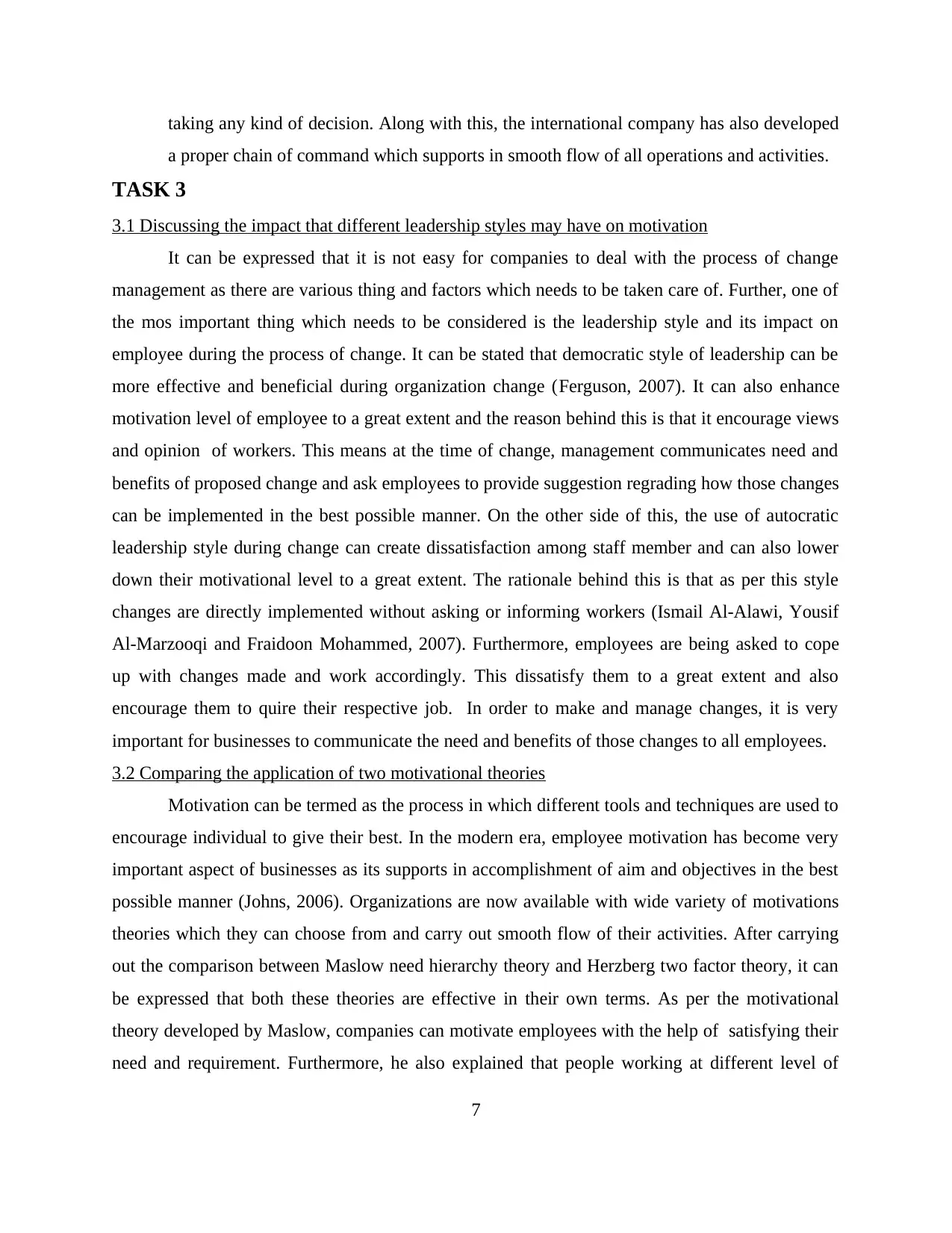
taking any kind of decision. Along with this, the international company has also developed
a proper chain of command which supports in smooth flow of all operations and activities.
TASK 3
3.1 Discussing the impact that different leadership styles may have on motivation
It can be expressed that it is not easy for companies to deal with the process of change
management as there are various thing and factors which needs to be taken care of. Further, one of
the mos important thing which needs to be considered is the leadership style and its impact on
employee during the process of change. It can be stated that democratic style of leadership can be
more effective and beneficial during organization change (Ferguson, 2007). It can also enhance
motivation level of employee to a great extent and the reason behind this is that it encourage views
and opinion of workers. This means at the time of change, management communicates need and
benefits of proposed change and ask employees to provide suggestion regrading how those changes
can be implemented in the best possible manner. On the other side of this, the use of autocratic
leadership style during change can create dissatisfaction among staff member and can also lower
down their motivational level to a great extent. The rationale behind this is that as per this style
changes are directly implemented without asking or informing workers (Ismail Al-Alawi, Yousif
Al-Marzooqi and Fraidoon Mohammed, 2007). Furthermore, employees are being asked to cope
up with changes made and work accordingly. This dissatisfy them to a great extent and also
encourage them to quire their respective job. In order to make and manage changes, it is very
important for businesses to communicate the need and benefits of those changes to all employees.
3.2 Comparing the application of two motivational theories
Motivation can be termed as the process in which different tools and techniques are used to
encourage individual to give their best. In the modern era, employee motivation has become very
important aspect of businesses as its supports in accomplishment of aim and objectives in the best
possible manner (Johns, 2006). Organizations are now available with wide variety of motivations
theories which they can choose from and carry out smooth flow of their activities. After carrying
out the comparison between Maslow need hierarchy theory and Herzberg two factor theory, it can
be expressed that both these theories are effective in their own terms. As per the motivational
theory developed by Maslow, companies can motivate employees with the help of satisfying their
need and requirement. Furthermore, he also explained that people working at different level of
7
a proper chain of command which supports in smooth flow of all operations and activities.
TASK 3
3.1 Discussing the impact that different leadership styles may have on motivation
It can be expressed that it is not easy for companies to deal with the process of change
management as there are various thing and factors which needs to be taken care of. Further, one of
the mos important thing which needs to be considered is the leadership style and its impact on
employee during the process of change. It can be stated that democratic style of leadership can be
more effective and beneficial during organization change (Ferguson, 2007). It can also enhance
motivation level of employee to a great extent and the reason behind this is that it encourage views
and opinion of workers. This means at the time of change, management communicates need and
benefits of proposed change and ask employees to provide suggestion regrading how those changes
can be implemented in the best possible manner. On the other side of this, the use of autocratic
leadership style during change can create dissatisfaction among staff member and can also lower
down their motivational level to a great extent. The rationale behind this is that as per this style
changes are directly implemented without asking or informing workers (Ismail Al-Alawi, Yousif
Al-Marzooqi and Fraidoon Mohammed, 2007). Furthermore, employees are being asked to cope
up with changes made and work accordingly. This dissatisfy them to a great extent and also
encourage them to quire their respective job. In order to make and manage changes, it is very
important for businesses to communicate the need and benefits of those changes to all employees.
3.2 Comparing the application of two motivational theories
Motivation can be termed as the process in which different tools and techniques are used to
encourage individual to give their best. In the modern era, employee motivation has become very
important aspect of businesses as its supports in accomplishment of aim and objectives in the best
possible manner (Johns, 2006). Organizations are now available with wide variety of motivations
theories which they can choose from and carry out smooth flow of their activities. After carrying
out the comparison between Maslow need hierarchy theory and Herzberg two factor theory, it can
be expressed that both these theories are effective in their own terms. As per the motivational
theory developed by Maslow, companies can motivate employees with the help of satisfying their
need and requirement. Furthermore, he also explained that people working at different level of
7
Paraphrase This Document
Need a fresh take? Get an instant paraphrase of this document with our AI Paraphraser
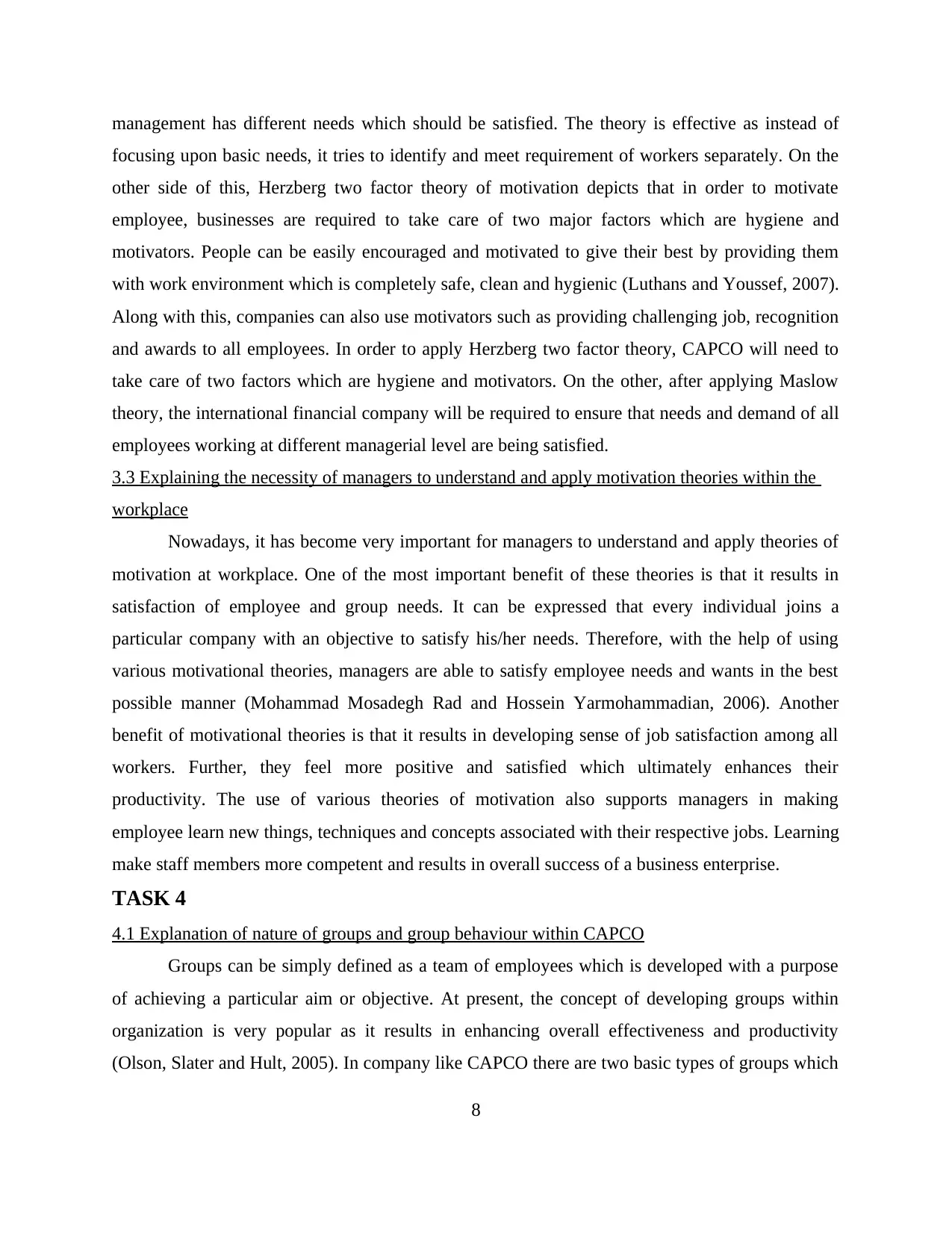
management has different needs which should be satisfied. The theory is effective as instead of
focusing upon basic needs, it tries to identify and meet requirement of workers separately. On the
other side of this, Herzberg two factor theory of motivation depicts that in order to motivate
employee, businesses are required to take care of two major factors which are hygiene and
motivators. People can be easily encouraged and motivated to give their best by providing them
with work environment which is completely safe, clean and hygienic (Luthans and Youssef, 2007).
Along with this, companies can also use motivators such as providing challenging job, recognition
and awards to all employees. In order to apply Herzberg two factor theory, CAPCO will need to
take care of two factors which are hygiene and motivators. On the other, after applying Maslow
theory, the international financial company will be required to ensure that needs and demand of all
employees working at different managerial level are being satisfied.
3.3 Explaining the necessity of managers to understand and apply motivation theories within the
workplace
Nowadays, it has become very important for managers to understand and apply theories of
motivation at workplace. One of the most important benefit of these theories is that it results in
satisfaction of employee and group needs. It can be expressed that every individual joins a
particular company with an objective to satisfy his/her needs. Therefore, with the help of using
various motivational theories, managers are able to satisfy employee needs and wants in the best
possible manner (Mohammad Mosadegh Rad and Hossein Yarmohammadian, 2006). Another
benefit of motivational theories is that it results in developing sense of job satisfaction among all
workers. Further, they feel more positive and satisfied which ultimately enhances their
productivity. The use of various theories of motivation also supports managers in making
employee learn new things, techniques and concepts associated with their respective jobs. Learning
make staff members more competent and results in overall success of a business enterprise.
TASK 4
4.1 Explanation of nature of groups and group behaviour within CAPCO
Groups can be simply defined as a team of employees which is developed with a purpose
of achieving a particular aim or objective. At present, the concept of developing groups within
organization is very popular as it results in enhancing overall effectiveness and productivity
(Olson, Slater and Hult, 2005). In company like CAPCO there are two basic types of groups which
8
focusing upon basic needs, it tries to identify and meet requirement of workers separately. On the
other side of this, Herzberg two factor theory of motivation depicts that in order to motivate
employee, businesses are required to take care of two major factors which are hygiene and
motivators. People can be easily encouraged and motivated to give their best by providing them
with work environment which is completely safe, clean and hygienic (Luthans and Youssef, 2007).
Along with this, companies can also use motivators such as providing challenging job, recognition
and awards to all employees. In order to apply Herzberg two factor theory, CAPCO will need to
take care of two factors which are hygiene and motivators. On the other, after applying Maslow
theory, the international financial company will be required to ensure that needs and demand of all
employees working at different managerial level are being satisfied.
3.3 Explaining the necessity of managers to understand and apply motivation theories within the
workplace
Nowadays, it has become very important for managers to understand and apply theories of
motivation at workplace. One of the most important benefit of these theories is that it results in
satisfaction of employee and group needs. It can be expressed that every individual joins a
particular company with an objective to satisfy his/her needs. Therefore, with the help of using
various motivational theories, managers are able to satisfy employee needs and wants in the best
possible manner (Mohammad Mosadegh Rad and Hossein Yarmohammadian, 2006). Another
benefit of motivational theories is that it results in developing sense of job satisfaction among all
workers. Further, they feel more positive and satisfied which ultimately enhances their
productivity. The use of various theories of motivation also supports managers in making
employee learn new things, techniques and concepts associated with their respective jobs. Learning
make staff members more competent and results in overall success of a business enterprise.
TASK 4
4.1 Explanation of nature of groups and group behaviour within CAPCO
Groups can be simply defined as a team of employees which is developed with a purpose
of achieving a particular aim or objective. At present, the concept of developing groups within
organization is very popular as it results in enhancing overall effectiveness and productivity
(Olson, Slater and Hult, 2005). In company like CAPCO there are two basic types of groups which
8
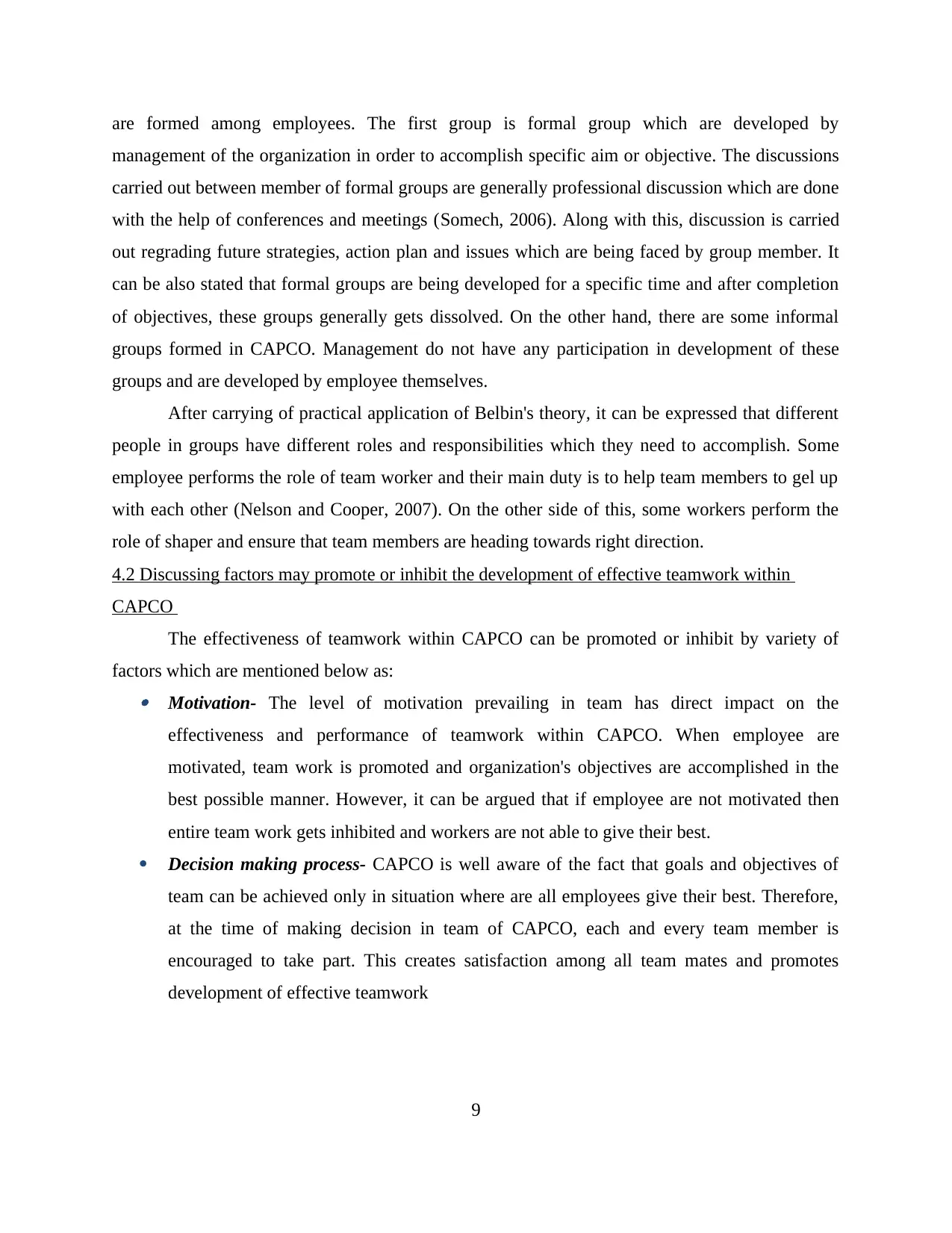
are formed among employees. The first group is formal group which are developed by
management of the organization in order to accomplish specific aim or objective. The discussions
carried out between member of formal groups are generally professional discussion which are done
with the help of conferences and meetings (Somech, 2006). Along with this, discussion is carried
out regrading future strategies, action plan and issues which are being faced by group member. It
can be also stated that formal groups are being developed for a specific time and after completion
of objectives, these groups generally gets dissolved. On the other hand, there are some informal
groups formed in CAPCO. Management do not have any participation in development of these
groups and are developed by employee themselves.
After carrying of practical application of Belbin's theory, it can be expressed that different
people in groups have different roles and responsibilities which they need to accomplish. Some
employee performs the role of team worker and their main duty is to help team members to gel up
with each other (Nelson and Cooper, 2007). On the other side of this, some workers perform the
role of shaper and ensure that team members are heading towards right direction.
4.2 Discussing factors may promote or inhibit the development of effective teamwork within
CAPCO
The effectiveness of teamwork within CAPCO can be promoted or inhibit by variety of
factors which are mentioned below as: Motivation- The level of motivation prevailing in team has direct impact on the
effectiveness and performance of teamwork within CAPCO. When employee are
motivated, team work is promoted and organization's objectives are accomplished in the
best possible manner. However, it can be argued that if employee are not motivated then
entire team work gets inhibited and workers are not able to give their best.
Decision making process- CAPCO is well aware of the fact that goals and objectives of
team can be achieved only in situation where are all employees give their best. Therefore,
at the time of making decision in team of CAPCO, each and every team member is
encouraged to take part. This creates satisfaction among all team mates and promotes
development of effective teamwork
9
management of the organization in order to accomplish specific aim or objective. The discussions
carried out between member of formal groups are generally professional discussion which are done
with the help of conferences and meetings (Somech, 2006). Along with this, discussion is carried
out regrading future strategies, action plan and issues which are being faced by group member. It
can be also stated that formal groups are being developed for a specific time and after completion
of objectives, these groups generally gets dissolved. On the other hand, there are some informal
groups formed in CAPCO. Management do not have any participation in development of these
groups and are developed by employee themselves.
After carrying of practical application of Belbin's theory, it can be expressed that different
people in groups have different roles and responsibilities which they need to accomplish. Some
employee performs the role of team worker and their main duty is to help team members to gel up
with each other (Nelson and Cooper, 2007). On the other side of this, some workers perform the
role of shaper and ensure that team members are heading towards right direction.
4.2 Discussing factors may promote or inhibit the development of effective teamwork within
CAPCO
The effectiveness of teamwork within CAPCO can be promoted or inhibit by variety of
factors which are mentioned below as: Motivation- The level of motivation prevailing in team has direct impact on the
effectiveness and performance of teamwork within CAPCO. When employee are
motivated, team work is promoted and organization's objectives are accomplished in the
best possible manner. However, it can be argued that if employee are not motivated then
entire team work gets inhibited and workers are not able to give their best.
Decision making process- CAPCO is well aware of the fact that goals and objectives of
team can be achieved only in situation where are all employees give their best. Therefore,
at the time of making decision in team of CAPCO, each and every team member is
encouraged to take part. This creates satisfaction among all team mates and promotes
development of effective teamwork
9
⊘ This is a preview!⊘
Do you want full access?
Subscribe today to unlock all pages.

Trusted by 1+ million students worldwide

4.3 Evaluating the impact of technology on team functioning within CAPCO
Nowadays, business uses variety of technological tools which supports them in carrying out
their operations effectively and smoothly. The team functioning in company such as CAPCO has
been affected in positive sense with the use of technology. As it has been already discussed that
CAPCO is an international company which operates in many countries of the world. Therefore, it
has developed various teams that are working at international level to achieve objectives of the
company. The use of technological tools such as mobile phones and computers has helped teams to
communicate with each other in more effective manner (Knights and Willmott, 2007). In order to
carry out discussion regrading issues, challenges and strategies now teams are no more required to
be physically present in front of each others. With the help of mobile messages and email or video
chats, team and their respective members can communicate easily from any location and at any
time (Nelson and Cooper, 2007). Technology has also positively affected team functioning within
CAPCO by improving the overall effectiveness and efficiency of every team member.
CONCLUSION
From the above study, it can be concluded that in order to achieve success and higher
growth, it is required to understand behaviour of people within a business enterprise.
Furthermore, it has been inferred that during the process of change management, democratic
style of leadership is more effective as it encourages workers to take part in decision-making
process. It can be also concluded that nowadays it is very important for managers to use different
motivational theories as it satisfy needs of employees and results in increasing their overall
effectiveness.
10
Nowadays, business uses variety of technological tools which supports them in carrying out
their operations effectively and smoothly. The team functioning in company such as CAPCO has
been affected in positive sense with the use of technology. As it has been already discussed that
CAPCO is an international company which operates in many countries of the world. Therefore, it
has developed various teams that are working at international level to achieve objectives of the
company. The use of technological tools such as mobile phones and computers has helped teams to
communicate with each other in more effective manner (Knights and Willmott, 2007). In order to
carry out discussion regrading issues, challenges and strategies now teams are no more required to
be physically present in front of each others. With the help of mobile messages and email or video
chats, team and their respective members can communicate easily from any location and at any
time (Nelson and Cooper, 2007). Technology has also positively affected team functioning within
CAPCO by improving the overall effectiveness and efficiency of every team member.
CONCLUSION
From the above study, it can be concluded that in order to achieve success and higher
growth, it is required to understand behaviour of people within a business enterprise.
Furthermore, it has been inferred that during the process of change management, democratic
style of leadership is more effective as it encourages workers to take part in decision-making
process. It can be also concluded that nowadays it is very important for managers to use different
motivational theories as it satisfy needs of employees and results in increasing their overall
effectiveness.
10
Paraphrase This Document
Need a fresh take? Get an instant paraphrase of this document with our AI Paraphraser
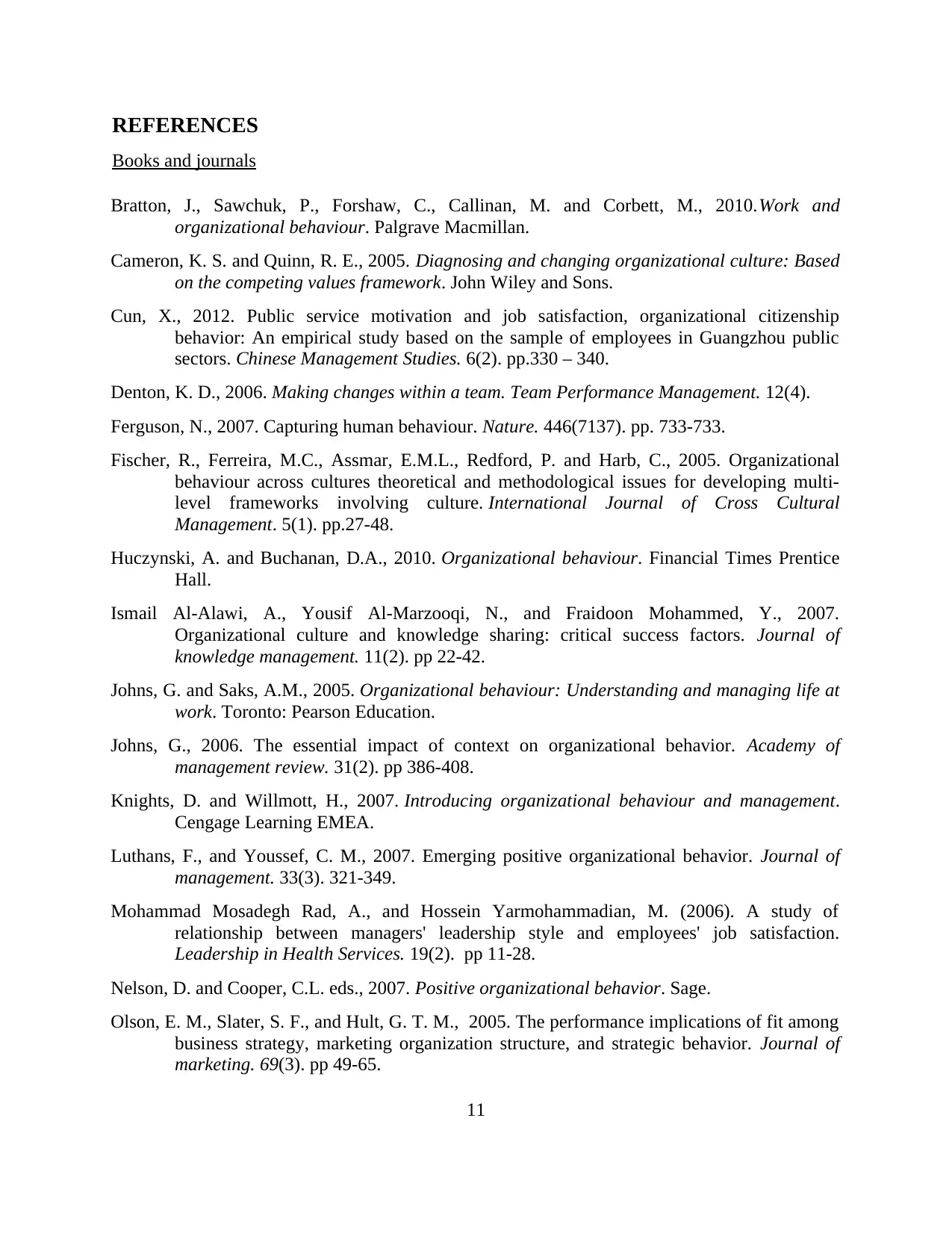
REFERENCES
Books and journals
Bratton, J., Sawchuk, P., Forshaw, C., Callinan, M. and Corbett, M., 2010.Work and
organizational behaviour. Palgrave Macmillan.
Cameron, K. S. and Quinn, R. E., 2005. Diagnosing and changing organizational culture: Based
on the competing values framework. John Wiley and Sons.
Cun, X., 2012. Public service motivation and job satisfaction, organizational citizenship
behavior: An empirical study based on the sample of employees in Guangzhou public
sectors. Chinese Management Studies. 6(2). pp.330 – 340.
Denton, K. D., 2006. Making changes within a team. Team Performance Management. 12(4).
Ferguson, N., 2007. Capturing human behaviour. Nature. 446(7137). pp. 733-733.
Fischer, R., Ferreira, M.C., Assmar, E.M.L., Redford, P. and Harb, C., 2005. Organizational
behaviour across cultures theoretical and methodological issues for developing multi-
level frameworks involving culture. International Journal of Cross Cultural
Management. 5(1). pp.27-48.
Huczynski, A. and Buchanan, D.A., 2010. Organizational behaviour. Financial Times Prentice
Hall.
Ismail Al-Alawi, A., Yousif Al-Marzooqi, N., and Fraidoon Mohammed, Y., 2007.
Organizational culture and knowledge sharing: critical success factors. Journal of
knowledge management. 11(2). pp 22-42.
Johns, G. and Saks, A.M., 2005. Organizational behaviour: Understanding and managing life at
work. Toronto: Pearson Education.
Johns, G., 2006. The essential impact of context on organizational behavior. Academy of
management review. 31(2). pp 386-408.
Knights, D. and Willmott, H., 2007. Introducing organizational behaviour and management.
Cengage Learning EMEA.
Luthans, F., and Youssef, C. M., 2007. Emerging positive organizational behavior. Journal of
management. 33(3). 321-349.
Mohammad Mosadegh Rad, A., and Hossein Yarmohammadian, M. (2006). A study of
relationship between managers' leadership style and employees' job satisfaction.
Leadership in Health Services. 19(2). pp 11-28.
Nelson, D. and Cooper, C.L. eds., 2007. Positive organizational behavior. Sage.
Olson, E. M., Slater, S. F., and Hult, G. T. M., 2005. The performance implications of fit among
business strategy, marketing organization structure, and strategic behavior. Journal of
marketing. 69(3). pp 49-65.
11
Books and journals
Bratton, J., Sawchuk, P., Forshaw, C., Callinan, M. and Corbett, M., 2010.Work and
organizational behaviour. Palgrave Macmillan.
Cameron, K. S. and Quinn, R. E., 2005. Diagnosing and changing organizational culture: Based
on the competing values framework. John Wiley and Sons.
Cun, X., 2012. Public service motivation and job satisfaction, organizational citizenship
behavior: An empirical study based on the sample of employees in Guangzhou public
sectors. Chinese Management Studies. 6(2). pp.330 – 340.
Denton, K. D., 2006. Making changes within a team. Team Performance Management. 12(4).
Ferguson, N., 2007. Capturing human behaviour. Nature. 446(7137). pp. 733-733.
Fischer, R., Ferreira, M.C., Assmar, E.M.L., Redford, P. and Harb, C., 2005. Organizational
behaviour across cultures theoretical and methodological issues for developing multi-
level frameworks involving culture. International Journal of Cross Cultural
Management. 5(1). pp.27-48.
Huczynski, A. and Buchanan, D.A., 2010. Organizational behaviour. Financial Times Prentice
Hall.
Ismail Al-Alawi, A., Yousif Al-Marzooqi, N., and Fraidoon Mohammed, Y., 2007.
Organizational culture and knowledge sharing: critical success factors. Journal of
knowledge management. 11(2). pp 22-42.
Johns, G. and Saks, A.M., 2005. Organizational behaviour: Understanding and managing life at
work. Toronto: Pearson Education.
Johns, G., 2006. The essential impact of context on organizational behavior. Academy of
management review. 31(2). pp 386-408.
Knights, D. and Willmott, H., 2007. Introducing organizational behaviour and management.
Cengage Learning EMEA.
Luthans, F., and Youssef, C. M., 2007. Emerging positive organizational behavior. Journal of
management. 33(3). 321-349.
Mohammad Mosadegh Rad, A., and Hossein Yarmohammadian, M. (2006). A study of
relationship between managers' leadership style and employees' job satisfaction.
Leadership in Health Services. 19(2). pp 11-28.
Nelson, D. and Cooper, C.L. eds., 2007. Positive organizational behavior. Sage.
Olson, E. M., Slater, S. F., and Hult, G. T. M., 2005. The performance implications of fit among
business strategy, marketing organization structure, and strategic behavior. Journal of
marketing. 69(3). pp 49-65.
11
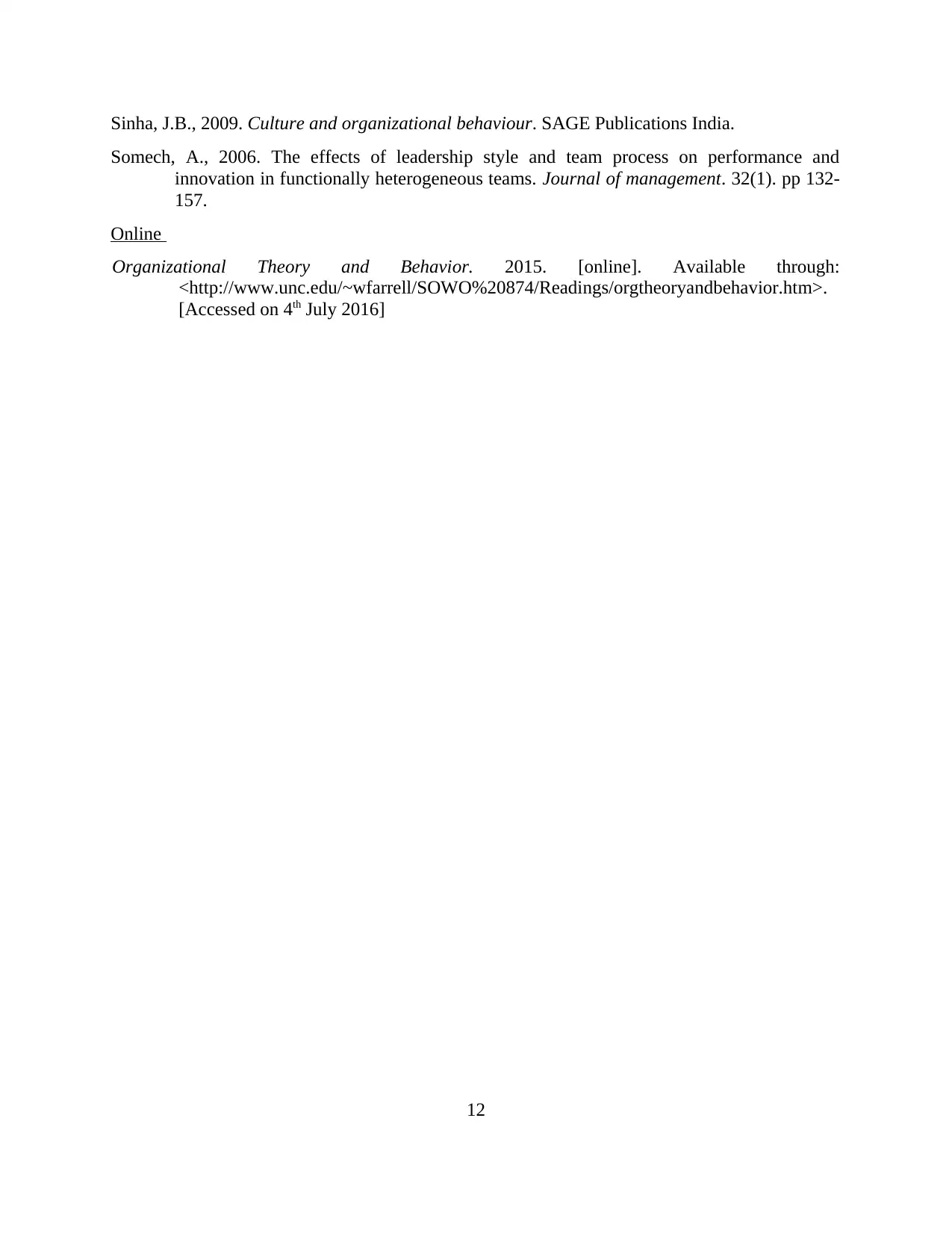
Sinha, J.B., 2009. Culture and organizational behaviour. SAGE Publications India.
Somech, A., 2006. The effects of leadership style and team process on performance and
innovation in functionally heterogeneous teams. Journal of management. 32(1). pp 132-
157.
Online
Organizational Theory and Behavior. 2015. [online]. Available through:
<http://www.unc.edu/~wfarrell/SOWO%20874/Readings/orgtheoryandbehavior.htm>.
[Accessed on 4th July 2016]
12
Somech, A., 2006. The effects of leadership style and team process on performance and
innovation in functionally heterogeneous teams. Journal of management. 32(1). pp 132-
157.
Online
Organizational Theory and Behavior. 2015. [online]. Available through:
<http://www.unc.edu/~wfarrell/SOWO%20874/Readings/orgtheoryandbehavior.htm>.
[Accessed on 4th July 2016]
12
⊘ This is a preview!⊘
Do you want full access?
Subscribe today to unlock all pages.

Trusted by 1+ million students worldwide
1 out of 12
Related Documents
Your All-in-One AI-Powered Toolkit for Academic Success.
+13062052269
info@desklib.com
Available 24*7 on WhatsApp / Email
![[object Object]](/_next/static/media/star-bottom.7253800d.svg)
Unlock your academic potential
Copyright © 2020–2025 A2Z Services. All Rights Reserved. Developed and managed by ZUCOL.





